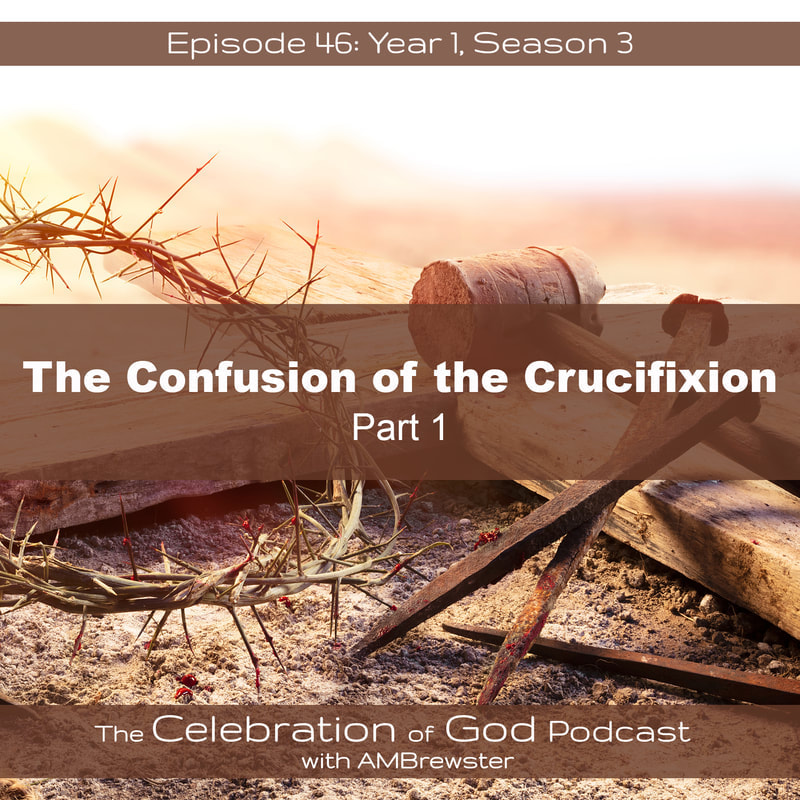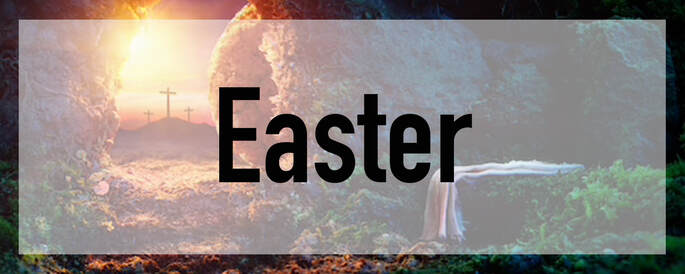Iron Sharpens Iron RadioCase for a Thursday CrucifixionThe following resources expand on AMBrewster's interview with Chris Arnzen concerning the "Case for a Thursday Crucifixion."
Podcast EpisodesEaster Week at a Glance
ArticlesAdditional Resurrection Sunday Resources | |||
AMBrewster's Notes
The Traditional View
A Case for a Thursday Crucifixion
Consider the women who went to anoint Jesus.
Consider the Elements of the Passover.
AMBrewster’s Journey to Discover the Date of the Crucifixion
In my research I hit a snag I hit in my study.
So, I finally found an explanation that perfectly matches up with all the biblical data, and that lead me to wonder . . . well, if we know that Jesus died on a Thursday that also happened to be the 14th of Nisan, we should able to figure out with a huge amount of certainty which year He died and — consequently — which day on the Gregorian calendar he died.
So, I searched . . . for a long time . . . in many places, and I was completely unable to find a Thursday that fell on Nisan 14 anywhere from AD 27 through AD 35. In fact, some sources told me that it’s impossible to the 14th of Nisan to ever fall on a Thursday because of the way it’s calculated with the moon cycles and so on. However, it frequently falls on a Friday.
Let’s just say, I was discouraged. I knew Jesus was crucified on Passover and rose on the first of the week. Those points cannot be argued. And because I couldn’t find a Passover that landed on Thursday, I started to understand why so many people were willing to overlook or explain away the whole three days and three nights thing in order to nail down a Friday date.
But then I learned that there are some significant issues with applying current calculation models to past Jewish years. Nearly all the Hebrew year calculators on the internet have no problem extrapolating out dates moving forward, but they can’t perfectly determine dates moving backward.
For example, the priests determined the calendar after the spring new moon when at least two witnesses independently verified that they had seen the first waxing crescent moon. Needless to say, there were definite possibilities for human error due to overcast nights and the like.
And then I found it!
The U.S. Naval Observatory Astronomical Applications Department calculated that in AD 34 the Vernal Equinox fell on Monday, March 22 and the astronomical new moon conjunction was Wednesday, April 7th (http://intercontinentalcog.org/Appendix/Passover_dates_26-34_AD.php)
Based on all of this, the first evening the waxing crescent after the new moon would have been visible was on Thursday, April 8th. That corresponds to the first day of Nisan. On the Gregorian Calendar, that would have been from Thursday evening on the 8th through Friday afternoon on the 9th.
All of this means that means that in AD 34, the 14th day of Nisan would have landed on a Thursday. And — on the Gregorian calendar — that Thursday would have been April 22nd.
My friends, I believe it’s safe to say that — according to our American calendar, our Lord and Savior Jesus Christ died at 3:00 pm on Thursday, April 22nd in AD 34.
- John MacArthur: “Some people have difficulty reconciling what Jesus said in Matthew 12:40 about the length of His stay in the grave: ‘As Jonah was three days and three nights in the belly of the great fish, so shall the Son of man be three days and three nights in the heart of the earth.’ Does that mean Jesus had to be in the earth three full days and nights? No. Many commentators take that view and back the crucifixion to Thursday, so the three days and nights are Thursday, Friday, and Saturday, with His rising on Sunday. The obvious problem with that view is that we are left with a fourth- day resurrection. Yet all the passages in Scripture dealing with this issue indicate He was to rise on the third day. That eliminates the need for interpreting Matthew 12:40 as referring to three 24-hour periods. The phrase ‘three days and three nights’ was simply an idiom of the Jewish people referring to a three-day period.”
- Scott Aniol: “The Wednesday crucifixion requires that Jesus have ridden into Jerusalem on the Saturday, which would have been another Sabbath violation, as would the cutting down of palm branches. It has Christ rising on the fourth day, if the “third day” is also the first day of the week. There is simply no evidence that Nisan 15 (the day after Passover) was a day on which no one worked. This is essentially a theory held only by those who hold to the Thursday crucifixion. There is no real case for a Passover Sabbath which occurred the day before the regular weekly Sabbath. The expression “the day of preparation” is universally used to mean Friday ((Matt. 27:62; Mark 15:42; Luke 23:54; John 19:14, 31, 42). Mark makes this especially clear “Now when evening had come, because it was the Preparation Day, that is, the day before the Sabbath” (Mk. 15:42). The great consensus of interpreters and scholars is that Jesus died on Friday. Yes, to keep the strict chronology and typology of the examination of the Passover Lamb, we probably have to accept it was really Palm Monday. Perhaps the complicated harmonizing of Galilean and Judean timekeeping might allow us to keep that one, since we have no Scripture telling us exactly what day of the week was the triumphal entry. But it seems the evidence does point fairly clearly to a Friday crucifixion.”
A Case for a Thursday Crucifixion
- Before grappling with this struggle, we have to acknowledge our own blindspots.
- Most of us are’t Jews. In addition, we Gentiles don’t truly understand all of the Jewish traditions the way we should. This adds some hurdles to our understanding of the course of events because the details God includes to help us navigate the Passion Week are foreign to us.
- We have our own cherished traditions. I am confident to assert that the vast majority of you have observed Good Friday as the day of our Lord’s death since you were very little. I’ve done the same. But though we may have our traditions and habits, we need to be willing to push those aside in light of the biblical material. Our traditions should no more supersede God’s Word than our own opinions.
- The main argument for the Friday crucifixion comes from Mark 15:42, “And now when the even was come, because it was the preparation, that is, the day before the sabbath.” And then the passage goes on to describe Jesus being taken from the cross. This means that Jesus was crucified the day before the Sabbath, and everyone knows the Jewish Sabbath is on Saturday. That’s why the majority of Christians observe the crucifixion on Friday.
- Mark 15:42 says that Jesus was crucified on the day of preparation. Now, with that evidence alone, it would be easy to assume that Jesus was crucified during the day on Friday, the day of Preparation before the weekend Sabbath.
- But, there are a number of issues with that, and it’s those issues that will be the focus of the remainder of this episode and the next.
- The Jews often had more than one Sabbath a week.
- Depending on the year, there were the 50 to 54 weekly Sabbaths, but there were also 2 sabbaths in the feast of Unleavened Bread, there’s the sabbath of Pentecost, 1 Feast of Trumpets, 1 Day of Atonement, and 2 sabbaths during the Feast of Tabernacles. That’s over 60 Sabbaths in one year!
- If we assume that the Mark 15:42 Sabbath is Saturday, then a Friday Crucifixion makes partial sense. But what if there were another Sabbath that week that landed before Saturday?
- The seven day Feast of Unleavened Bread is preceded by the Feast of the Passover, which was celebrated in remembrance of the Israelites being delivered from Egypt. This Passover falls on the 14th of Nisan and the Feast of Unleavened Bread officially started on the 15th.
- Aniol: “There is simply no evidence that Nisan 15 (the day after Passover) was a day on which no one worked. This is essentially a theory held only by those who hold to the Thursday crucifixion. There is no real case for a Passover Sabbath which occurred the day before the regular weekly Sabbath.”
- Leviticus 23:5-8, “In the first month, on the fourteenth day of the month at twilight is the Lord’s Passover. 6 Then on the fifteenth day of the same month there is the Feast of Unleavened Bread to the Lord; for seven days you shall eat unleavened bread. 7 On the first day you shall have a holy convocation; you shall not do any laborious work. 8 But for seven days you shall present an offering by fire to the Lord. On the seventh day is a holy convocation; you shall not do any laborious work.’”
- Exodus 12:14-16, “Now this day will be a memorial to you, and you shall celebrate it as a feast to the Lord; throughout your generations you are to celebrate it as a permanent ordinance. 15 Seven days you shall eat unleavened bread, but on the first day you shall remove leaven from your houses; for whoever eats anything leavened from the first day until the seventh day, that person shall be cut off from Israel. 16 On the first day you shall have a holy assembly, and another holy assembly on the seventh day; no work at all shall be done on them, except what must be eaten by every person, that alone may be prepared by you.”
- Number 28:17-18, “On the fifteenth day of this month shall be a feast, unleavened bread shall be eaten for seven days. 18 On the first day shall be a holy convocation; you shall do no laborious work.”
- Mark 14:1, “Now the Passover and Unleavened Bread were two days away; and the chief priests and the scribes were seeking how to seize Him by stealth and kill Him.”
- Nisan 15 can fall on multiple days just like December 25th can fall on any day of the week. But regardless of on what day it falls, the first day of the Feast of Unleavened Bread is considered a High Sabbath, called simply a High Day. As a High Sabbath, it too is preceded by its own day of preparation which would have been the 14th, also the Passover.
- John 19:31, "Then the Jews, because it was the day of preparation, so that the bodies would not remain on the cross on the Sabbath (for that Sabbath was a high day), asked Pilate that their legs might be broken, and that they might be taken away."
- Jesus gave us the timeline of 3 days and 3 nights.
- Matthew 12:40, "For just as Jonah was three days and three nights in the belly of the sea monster, so will the Son of Man be three days and three nights in the heart of the earth."
- Jesus made it very clear that he would be “in the heart of the earth” for three days and three nights. And I know it may be weird to say, but it’s completely appropriate to take Christ literally.
- We know for certain that Jesus was raised from the dead on Sunday, the first day of the week. In order to have been in the heart of the earth for three days and three nights, Jesus would have to have been buried during the day on Thursday.
- Matthew and John were very precise that Jesus raised before the daytime hours on Sunday. Had He risen after the sunrise, He would have been in the heart of the earth for four days and three nights.
- Three days and three nights — in that order. His first day in the grave started it and His last night in the grave ended it.
- Jesus also gave us the timeline of three total days.
- John 2:19-2, "'What sign do You show us as your authority for doing these things?' 19 Jesus answered them, 'Destroy this temple, and in three days I will raise it up.' 20 The Jews then said, 'It took forty-six years to build this temple, and will You raise it up in three days?' 21 But He was speaking of the temple of His body."
- Mark 8:31, "And He began to teach them that the Son of Man must suffer many things and be rejected by the elders and the chief priests and the scribes, and be killed, and after three days rise again."
- Jesus was not in the grave the entire day on Thursday nor every minute of the third night.
- Technically, Jesus was in the grave all day on Friday and Saturday. That’s two full days. But He was only in the grave half the day on Thursday and half the evening on Sunday (that would be our Saturday night).
- Those two half days equal the third day.
- This is consistent with the fact that Jesus said He would raise up His temple in three days.
- This counting method counts each daytime period as one day, with the resurrection taking place “after three days.” The day was not over when Jesus died in the afternoon, so this begins with the day of the crucifixion.
- Therefore, a Thursday crucifixion also fits with Jesus being raised up “after three days.”
- The Bible clearly says that Jesus rose before the morning hours on Sunday. And Jesus said that he would be in the earth for three days and nights. The math is clear, the Jewish “Thursday” would have to be the day. There are not enough days or nights if Christ were crucified on Friday.
- In Luke 24:21 we hear the disciples say to the man (Whom they did not yet recognize as Jesus), “We had hoped that he was the one to redeem Israel. Yes, and besides all this, it is now the third day since these things happened.”
- This discussion happened on Sunday, the day Christ resurrected. Again, the number of days fits with a Thursday crucifixion — Thursday day, Friday night, Friday day, Saturday night, Saturday day, Sunday night. Those represent three sets of days and nights that — to the disciples walking down the road to Emmaus — happened three days ago.
Consider the women who went to anoint Jesus.
- Matthew 28:1; Mark 16:1; John 19:39-40; Acts 2:27
- Though they were running late, these women wouldn’t have attempted to anoint the body four days late, so they headed out before the sun was up to get in on the tale end of the third evening.
- But why not just anoint Jesus on Thursday, Friday, or Saturday? Well, a Thursday crucifixion would have put the body in the tomb right before sundown on the Passover. Friday was a High Sabbath of the Feast of Unleavened Bread and Saturday was the weekly Sabbath; the best these ladies could have done was to wait until Sunday. Otherwise, they would have been breaking God’s law.
Consider the Elements of the Passover.
- John 12; Exodus 12:3; I Corinthians 15:20; Leviticus 23:12-13
- John 12 tells us that six days prior to the Passover, Jesus visited Lazarus, Mary, and Martha. Since the Passover was on the 14th of Nisan, then six days earlier would have been the 8th of Nisan. So, Jesus would have arrived during the daytime hours on Friday which would have been the 8th. Friday evening would have ushered in the weekly Sabbath (the 9th of Nissan). However, the meal Martha served and the anointing of Jesus performed by Mary would have been very wrong had they been done on the Sabbath.
- Therefore, the meal and anointing described in John 12 happened on Saturday evening, the 10th of Nisan which was no longer the Sabbath. Later in the day, the daytime hours of Sunday, Jesus entered into Jerusalem on what we call Palm Sunday.
- But Palm Sunday had more significance to the Jews than many of us realize. The lambs that were sacrificed on the 14th of Nisan were selected on the 10th of Nisan. We learn that in Exodus 12:3.
- After they were selected, they were presented for inspection that same day. Jesus did just that in presenting Himself when He rode into Jerusalem.
- The lambs selected for the sacrifice were then taken home and inspected over the next four days to be certain they were pure and spotless. It’s interesting to note that the next few day Jesus was also questioned and tested by the Jewish leaders.
- This tradition of taking the lamb home was also done so that the family would feel the impact of sacrificing this adorable lamb that had lived in their house as a member of the family for the better part of a week.
- Then on the 14th of Nisan, the Passover lambs were killed and their blood was spilled. The blood was then placed over the doorposts in remembrance of the first Passover and of God’s deliverance of His people from Egyptian bondage. With the 10th of Nisan on a Sunday, the day of crucifixion — four days later — would have been Thursday, the 14th of Nisan.
- But just like the entrance of Christ into Jerusalem had multiple levels of significance, the day of Jesus’ death was no coincidence either.
- Jesus and His disciples celebrated the Passover as early in the Jewish day as the possibly could (Wednesday night on the 14th of Nisan). Jesus did this for two reasons: First, because He knew what was going to happen later that day, and second, many of the Jews celebrated the Passover at home earlier in the day while the chief priest and pharisees and others like them celebrated it later in the day at the Temple.
- So Jesus and the disciples go out to Gethsemane, and the rest is history. Jesus is slaughtered on the same day that Passover lambs were slain and sacrificed. That still would have been the 14th of Nisan, but it would have been Thursday during the day.
- Jesus is buried before Thursday evening which would have been the 15th of Nisan and the High Sabbath Feast of Unleavened Bread.
- Now, normally, the Feast of First Fruits would have been the very next day after the Feast of Unleavened Bread, but the waiving of the sheafs was not allowed to take place on a Sabbath. Since the High Sabbath of Unleavened Bread happened right before the regular weekly Sabbath, the Feast of First Fruits had to wait until Sunday. The 17th of Nisan obviously would have started on Saturday evening, but during the day time hours on Sunday morning, the priests would wave a sheaf of grain before the Lord as an act of recognizing the provision of the Lord in the barley harvest.
- Jesus had to raise on this day. Just as Jesus fulfilled the sacrifice of Passover and the Feast of Unleavened Bread, He also fulfilled the Feast of First Fruits when He rose from the grave and ascended to His Father. His ascension was a type of wave offering, and just as the first fruits of the harvest were waved as an offering to the Lord, Jesus ascended to the Father as the first fruits of the resurrection.
- Jesus was the lamb of the meat offering, and His blood was the wine of the drink offering. With His Resurrection before the Father on Sunday morning, the Lord Jesus Christ fulfilled the Feast of First Fruits.
- So, with the selection of the lamb on the 10th day of Nisan (the day Jesus entered Jerusalem) and the wave, meat, and drink offerings of the Feast of First Fruits, Jesus was the fulfillment of the entire Passover.
- All of the following events took place on the 17th of Nisan:
- Noah’s Ark safely rested on Mt. Ararat (Genesis 8:4. Note that the seventh month was later designated as the first month at the time of the Exodus, Exodus 12:2).
- Hebrews entered Egypt (Exodus 12:40-41) 430 years before deliverance.
- Moses led the Israelites through the Parting of the Red Sea (Exodus 3:18, 5:3)
- Israel entered and ate the first fruit of the Promised Land (Joshua 5:10-12)
- The cleansing of the Temple by Hezekiah (eight hundred years after entering the promised land. (2 Chronicles 29:1-28)
- Queen Esther saved the Jews from Elimination (Esther 3:12, 5:1)
- The Resurrection of the Messiah
- God miraculously used Nisan 17 to be a day of new beginnings. What more perfect day could there have been for Christ to rise?
AMBrewster’s Journey to Discover the Date of the Crucifixion
In my research I hit a snag I hit in my study.
So, I finally found an explanation that perfectly matches up with all the biblical data, and that lead me to wonder . . . well, if we know that Jesus died on a Thursday that also happened to be the 14th of Nisan, we should able to figure out with a huge amount of certainty which year He died and — consequently — which day on the Gregorian calendar he died.
So, I searched . . . for a long time . . . in many places, and I was completely unable to find a Thursday that fell on Nisan 14 anywhere from AD 27 through AD 35. In fact, some sources told me that it’s impossible to the 14th of Nisan to ever fall on a Thursday because of the way it’s calculated with the moon cycles and so on. However, it frequently falls on a Friday.
Let’s just say, I was discouraged. I knew Jesus was crucified on Passover and rose on the first of the week. Those points cannot be argued. And because I couldn’t find a Passover that landed on Thursday, I started to understand why so many people were willing to overlook or explain away the whole three days and three nights thing in order to nail down a Friday date.
But then I learned that there are some significant issues with applying current calculation models to past Jewish years. Nearly all the Hebrew year calculators on the internet have no problem extrapolating out dates moving forward, but they can’t perfectly determine dates moving backward.
For example, the priests determined the calendar after the spring new moon when at least two witnesses independently verified that they had seen the first waxing crescent moon. Needless to say, there were definite possibilities for human error due to overcast nights and the like.
And then I found it!
The U.S. Naval Observatory Astronomical Applications Department calculated that in AD 34 the Vernal Equinox fell on Monday, March 22 and the astronomical new moon conjunction was Wednesday, April 7th (http://intercontinentalcog.org/Appendix/Passover_dates_26-34_AD.php)
Based on all of this, the first evening the waxing crescent after the new moon would have been visible was on Thursday, April 8th. That corresponds to the first day of Nisan. On the Gregorian Calendar, that would have been from Thursday evening on the 8th through Friday afternoon on the 9th.
All of this means that means that in AD 34, the 14th day of Nisan would have landed on a Thursday. And — on the Gregorian calendar — that Thursday would have been April 22nd.
My friends, I believe it’s safe to say that — according to our American calendar, our Lord and Savior Jesus Christ died at 3:00 pm on Thursday, April 22nd in AD 34.












